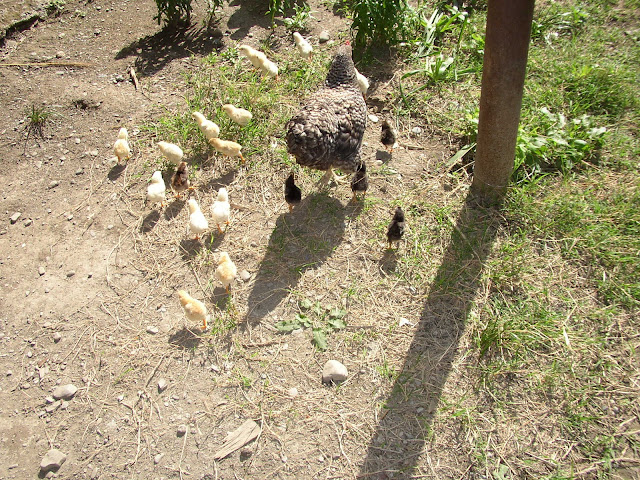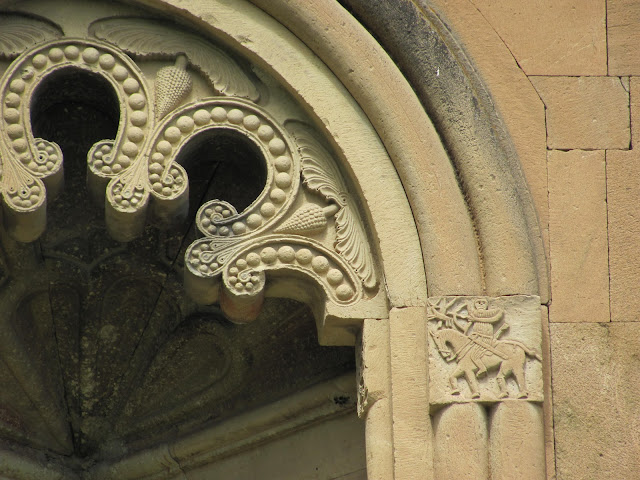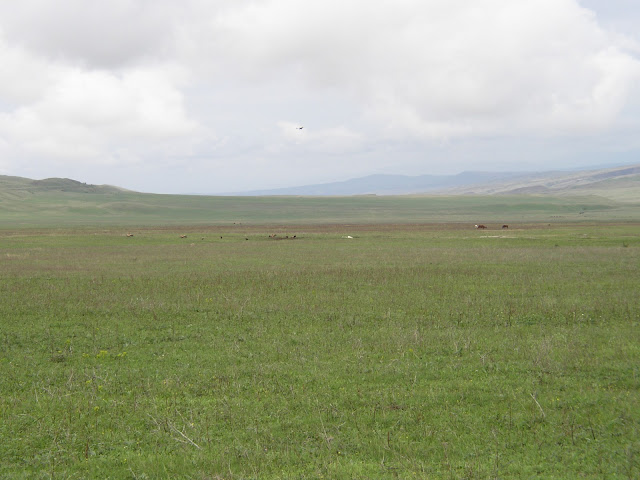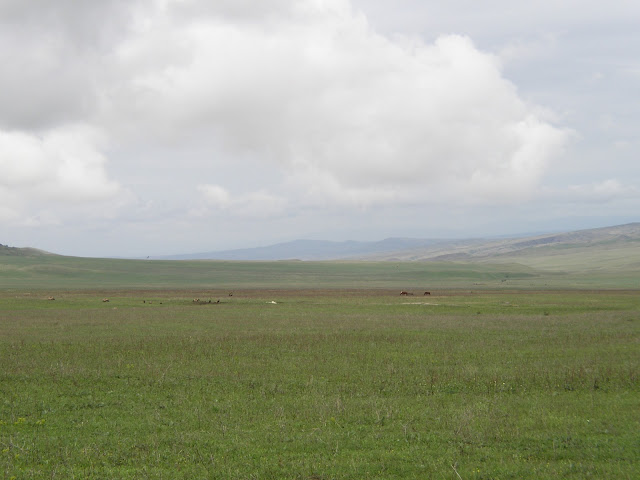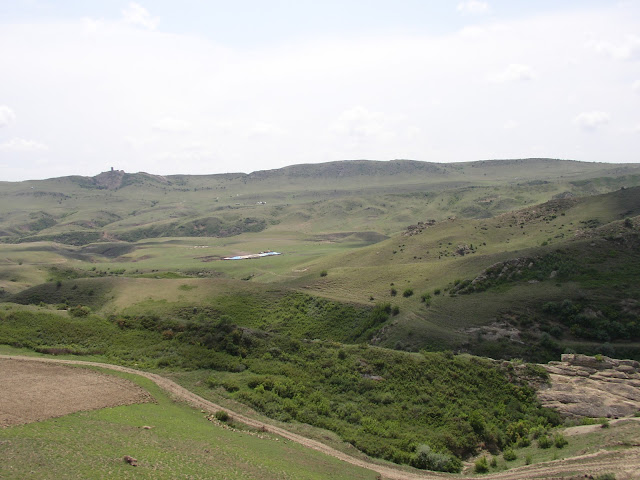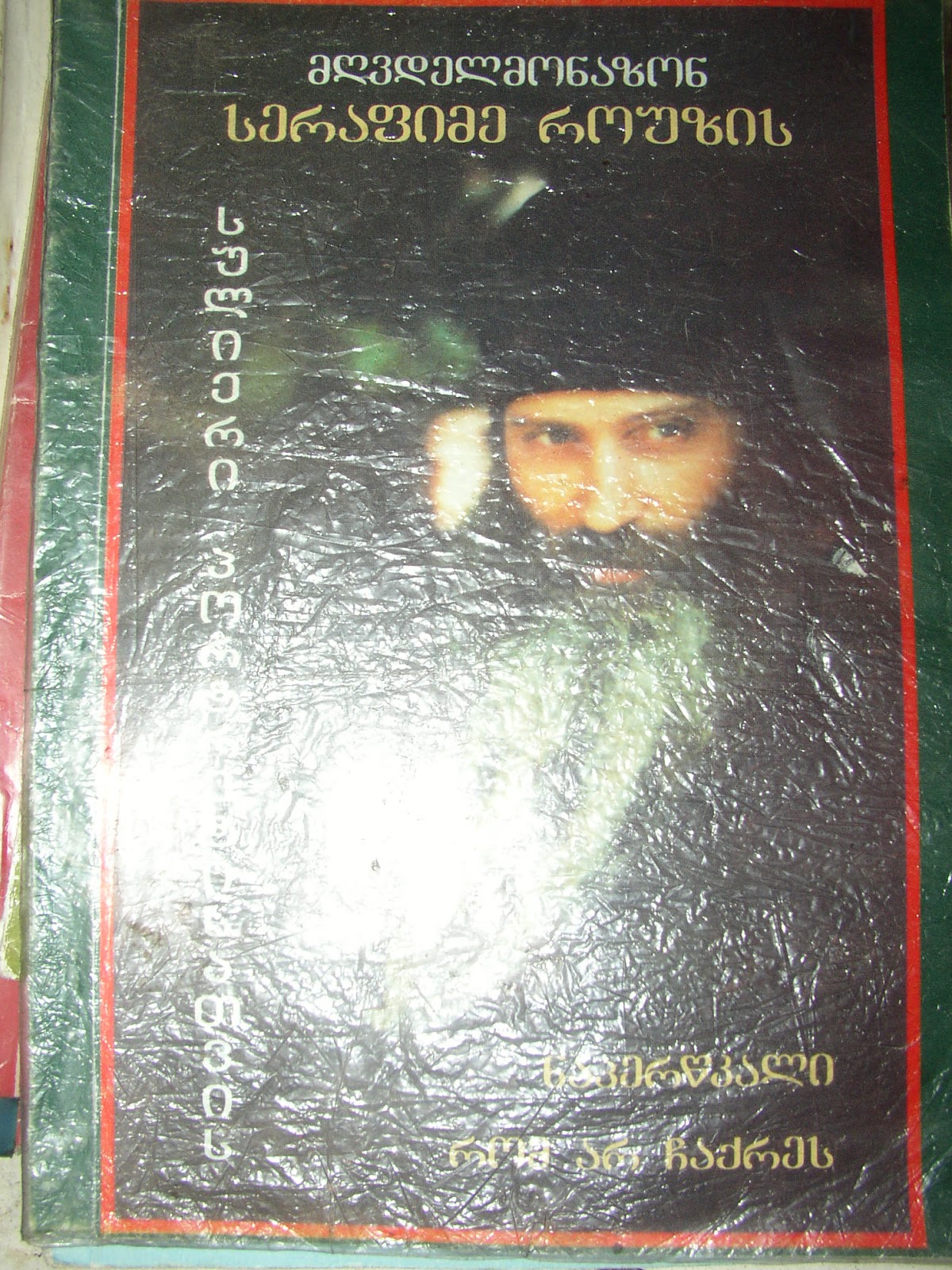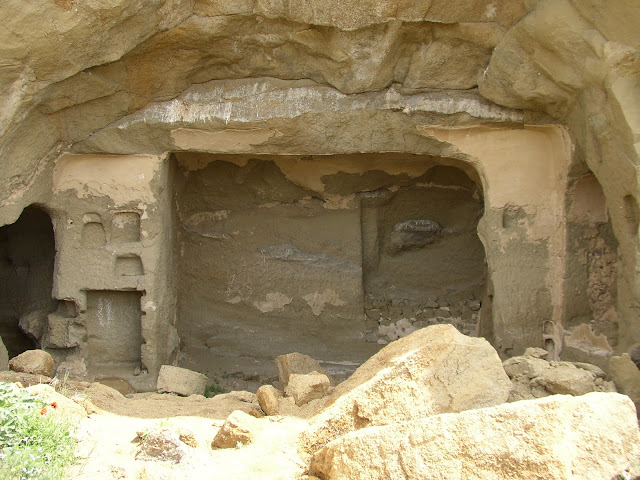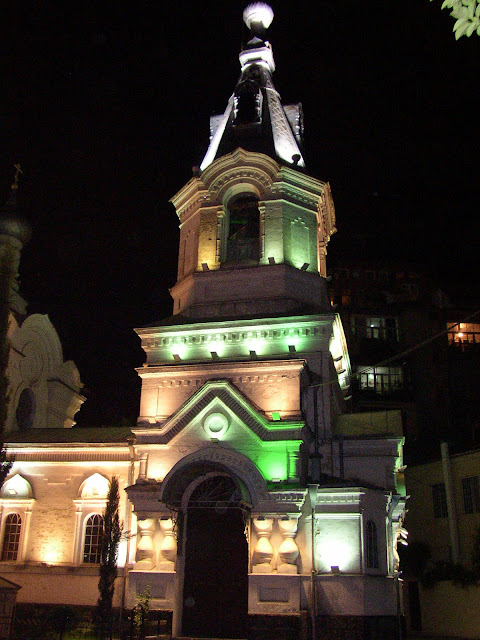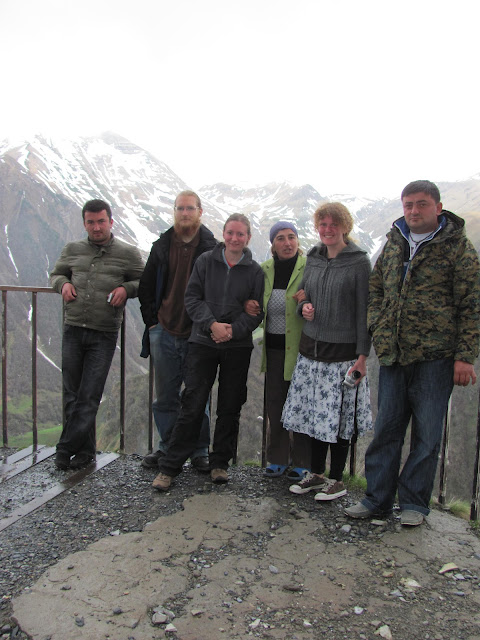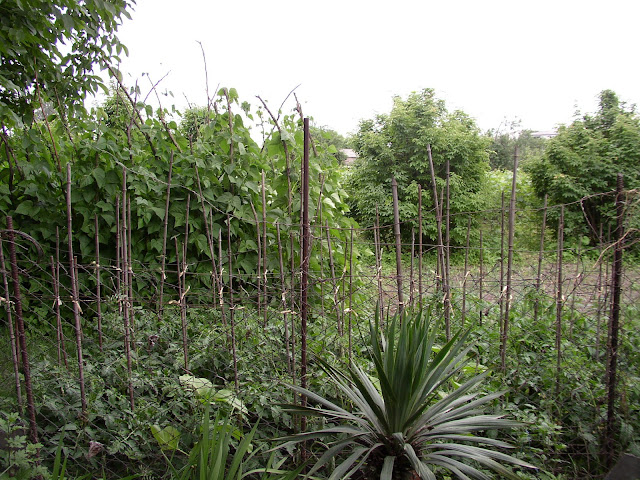This would have been just a couple more pictures, but now it's been a little over a month since I was going to post this, as we've had absolutely no internet at school. These first few were taken on my friend Amy's camera. She's a fellow volunteer, American, and friend, and I've mentioned her in a few posts before.
 Keti (a Georgian who wanted a picture with us, and who has since helped get me some cool hagiographical texts on Georgian saints), me, and Amy, the aforementioned volunteer.
Keti (a Georgian who wanted a picture with us, and who has since helped get me some cool hagiographical texts on Georgian saints), me, and Amy, the aforementioned volunteer.
 Us with a ramdom Georgian man. I want to say him tame was something like Tamuri, but I don't really remember--it was almost two months ago.
Us with a ramdom Georgian man. I want to say him tame was something like Tamuri, but I don't really remember--it was almost two months ago.
 What the Georgians call a "buffalo" (that's in the dictionary); it may
be a sort of buffalo, but I would just say "ox" to avoid confusion. Amy
thought this baby one was cute. It just kinda watched us walking by.
What the Georgians call a "buffalo" (that's in the dictionary); it may
be a sort of buffalo, but I would just say "ox" to avoid confusion. Amy
thought this baby one was cute. It just kinda watched us walking by.
 At my host dad's cousin's house. Good Georgian-style icons. Sorry about the lighting; it was late and they were in bed in the next room (hazy glass door in between), so I didn't want to use flash.
At my host dad's cousin's house. Good Georgian-style icons. Sorry about the lighting; it was late and they were in bed in the next room (hazy glass door in between), so I didn't want to use flash.
 Outside the "Green Monastery," thus called because of the flora. This was a monastery that was the center, at one time, of one of the greter monastic areas in Georgia, but then the Turks (I think; maybe Persians?) slaughtered them all. This is a TLG excursion (25 volunteers and a few Goergians).
Outside the "Green Monastery," thus called because of the flora. This was a monastery that was the center, at one time, of one of the greter monastic areas in Georgia, but then the Turks (I think; maybe Persians?) slaughtered them all. This is a TLG excursion (25 volunteers and a few Goergians).
 Inside the bell tower. See my January photo blog on what the bones are/are for.
Inside the bell tower. See my January photo blog on what the bones are/are for.
 On the road to Vardzia, near the southern border. You can see some really different environments in a really short period of time travelling through Georgia.
On the road to Vardzia, near the southern border. You can see some really different environments in a really short period of time travelling through Georgia.
One of the obedientss opened St. Nicholas' Church for me, and wanted to take a picture of me.
April 21:
 Keti (a Georgian who wanted a picture with us, and who has since helped get me some cool hagiographical texts on Georgian saints), me, and Amy, the aforementioned volunteer.
Keti (a Georgian who wanted a picture with us, and who has since helped get me some cool hagiographical texts on Georgian saints), me, and Amy, the aforementioned volunteer.
April 22:
 Us with a ramdom Georgian man. I want to say him tame was something like Tamuri, but I don't really remember--it was almost two months ago.
Us with a ramdom Georgian man. I want to say him tame was something like Tamuri, but I don't really remember--it was almost two months ago.
Lia and me. She's our best chanter, but she lives in the nearby village, and thus can't always be at Church. She sang in the Patriarchate Choir (i.e., in the choir of the main cathedral of all Georgia).
April 23:
April 25:
 What the Georgians call a "buffalo" (that's in the dictionary); it may
be a sort of buffalo, but I would just say "ox" to avoid confusion. Amy
thought this baby one was cute. It just kinda watched us walking by.
What the Georgians call a "buffalo" (that's in the dictionary); it may
be a sort of buffalo, but I would just say "ox" to avoid confusion. Amy
thought this baby one was cute. It just kinda watched us walking by.
April 27:
 At my host dad's cousin's house. Good Georgian-style icons. Sorry about the lighting; it was late and they were in bed in the next room (hazy glass door in between), so I didn't want to use flash.
At my host dad's cousin's house. Good Georgian-style icons. Sorry about the lighting; it was late and they were in bed in the next room (hazy glass door in between), so I didn't want to use flash.
Theotokos with Child, of course.
Sts. Peter and Paul.
St. Nicholas.
April 28:
 Outside the "Green Monastery," thus called because of the flora. This was a monastery that was the center, at one time, of one of the greter monastic areas in Georgia, but then the Turks (I think; maybe Persians?) slaughtered them all. This is a TLG excursion (25 volunteers and a few Goergians).
Outside the "Green Monastery," thus called because of the flora. This was a monastery that was the center, at one time, of one of the greter monastic areas in Georgia, but then the Turks (I think; maybe Persians?) slaughtered them all. This is a TLG excursion (25 volunteers and a few Goergians).
The bell tower.
 Inside the bell tower. See my January photo blog on what the bones are/are for.
Inside the bell tower. See my January photo blog on what the bones are/are for.  On the road to Vardzia, near the southern border. You can see some really different environments in a really short period of time travelling through Georgia.
On the road to Vardzia, near the southern border. You can see some really different environments in a really short period of time travelling through Georgia.
You can see it raining afar off.
You see where that guy is trying to climb up the wall? Keep that place in mind.
The feet on the right are on the wall where you saw that guy climbing up; this is the other side. In a moment, my camera's about to fall down, bounce off this wall, and land down there, before being rained on.
And this is the test photo (of other volunteers), after we found a way to rescue my camera. Other than it being really difficult to open the first time, it works fine.
And this is Vardzia. A very old cave city/monastery (it dualled as both) built by St. Queen Tamar, and where the lord of this area lived, it was a major city on travel and trade routes into and out of Georgia. It used to be enclosed (i.e., you couldn't see it from outside), but after an earthquake a lot of it fel and was destroyed. There are still monks living there to this day.
We've now walked up to it and are beginning to explore. Note the detailed work; this was a long time ago, and it was all hand tools..
A ventilation pipe, also from the original construction.
And this fresco in the main church in the caves depicts Queen Tamar. It's one of three pictures of her still extant that were drawn in life, and the only one (I think) that is an icon.
The apse.
A random side-tunnel.
At the end of said tunnel, looking down a deep shaft (we are protected from falling in by those bars).
See, you can see my foot.
Without flash, so you can see how dark it was.
The tunnels were definately all old.
Behind the church pictured above.
A table.
A wine pot.
Steep tunnels + rain = (sarcastic) fun!
May 5:
Don't remember which church this is; sorry. Amy's Georgian friend, Guchi, arranged a day of monastery travel for some volunteers.
Very Russian (realistic icons) style iconostasis, from when the Russia annexed Georgia before the USSR period.
Some carvings.
Rk'onis Monastery, a small monastery (I didn't see any monks, though). BEAUTIFUL nature. It reminded me of the Green Monastery above, though there were also evergreens there, which as a Washingtonian, I love.
The actual church.
Or should I say churches?
Queen Tamar's bridge, a classic example of midaeval Georgian bridge design, is on the monastery grounds.
A random dog followed us from the church to the bridge. It was freindly, though.
What did I say about the nature? And the whole time we were there, we only saw one other group of pilgrims, and only of four--and that's unheard of for a monastery in Georgia, for the most part.
A small building way up on a mountain. I walked up to it; it looks like it used to be a chapel, but has been interiorly demolished over time. It looked like perhaps people were going to work on restoring it.
Other volunteers (left two) and our Georgian guide, Guchi. The middle girl is also Orthodox, by the name of Irene, and we had some good chats and enjoyed chating together in English for a while as we walked (neither of us have had the chance to do that here, and there are certain hymns around Holy Week and Easter that we were both missing).
Not sure what this is; these are Amy's photos.
This is Chachubet'i, another church. As you can see, it is from the tenth century, and then more work was done in the thirteenth and fourteenth centuries on it.
Our marchutka (public transport bus we hired) stopped outside a shop. Though I'd seen hanging meat before (it's a norm), seeing specifically just hooves was new for me.
This was also a bit different. Usually you'll see an entire cow leg or a half a pig hanging up (they cover it with sheets in the hot months), and then they cut off however much each customer wants.
Kvatabkhevi. A monastery.
A Georgian Shepherd Dog.
Now in the city of Mtskheta; just some nice houses, these.
Svet'iskhoveli, which has been in my blog before.
Jvari (Cross) Monastery, from afar. It has also appeared in my blog before.
The main entrance to Svet'iskhoveli.
This is outside the door; the two scenes you can see are (left) the miracle of the "living pillar" "svet'iskhoveli," and (right) St. Elijah/Elias/Ilia, being taken up.
May 8:
Outside Davit-Gareji, a monastic complex in southeastern Georgia. There were very different animals; these turned out to be buzzards of some kind.
Views over the hill, towards where the actual monasteries are.
This building was really small, an old church on a hill which unfortunately had the ground underneath half of it fall away.
That's a monastery there, but it's disputed with Azerbaijan, and their militia will stop you form going there; there aren't any monks living there currently.
Looking down as I walk towards the church on a hill.
A turtle, and the first I've seen in Georgia.
A snake; I thought is was the poisonous kind, as there are a lot of poisonous snakes near the summer months (and yes, I was within a few feet from it even thinking it so). Apparently, the poisonous ones are more grey, though. Either way, they always slither away (really quick) when you approach, unless they're asleep, like this one.
You can see the chapel half here, and the lone cell underneath it where a hermit lives (and my bag, on a bench). I had a wonderful conversation with this man who lives his life in the desert silence of hesychia.
He directed me onwards; this is looking back from afar.
The path I was going down; you can see the ladder on the left.
A different species of ants, relatively big and quite fast.
For size comparison.
May 9:
The vegetable garden for the next monastery, St. Dodo's Horn.
The garden on the left, the valley and some vegetables undercellophane (done by the villagers who live not too far away, not the monks) ahead.
The cells at this monastery.
The stairs I just came down.
The trapeza, where they eat.
Me, Schema-igumen Serap'ion and Monk P'avle. Though I was only with them a short time, I could easily feel how loving they were.
The bell, and looking out.
The church.
Old frescos, unfortunately fading away and breaking off.
A little higher up, a small chapel; across the ribbon are the relics of St. Dodo, who founded the monastery.
The old Pantokrator icon.
The hills as seen from St. Davit's Lavra, across the valley.
The old cells (some monks still live in them, but some are uninhabitable when it rains).
A view of the opposite enclosing cliff, from the courtyard in the monks' area.
Looking down.
The church of St. Nicholas (of Myra).
Now in the lower church, of the Transfiguration. I love this style of cross.
The iconography had been redone in the Russian period, and then redone again in traditional Georgian style. Absolutely gorgeous.
St. Davit of Gareji's relics. When pilgriming to Jerusalem, when he got close enough to see the city, in his humility, he dared not walk in the path of Christ. He took three stones and called it sufficient, and returned. An angel then appeared to the patriarch of Jerusalem and said that Davit, a monk from Gareji, was taking the grace of Jerusalem away in the form of three stones, by his faith. The patriarch sent a messenger, who explained the matter and, as the angel had commanded, took two back, that the grace of Jerusalem not be completely taken away, but one being allowed for him, on account of this great faith and humility. It is called the "stone of peace," and many miracles have been wrought through it.
An icon of the 600 martyrs of Davit-Gareji, martyred on Pascha (Easter) night. They were doing processional with their candles in the night, and the ruler (pagan) said, upon hearing what it was, cried out, "Have we not yet killed all the Christians in this land?" and hastened to have them martyred. I especially liked it, showing the different ways in which they gave up their souls, and the crowns descending upon them.
May 10:
Fr. Seraphim Rose's life. An American holy monk (I believe him a saint), beloved by many in Georgia (and Russia and Greece and Serbia, and the list goes on). It was in the cell I stayed the night in.
I climbed up to see the frescoed church caves on the now-uninhabitied monastery of Udabno on the other side of the mountain Davit's Lavra is on. This pictures are taken from the path to it.
Some caves in the rock; you'll see them better later.
Looking (via flash) into a barred-off old room on a hill.
There were lots of bats in it, and this was an unaimed shot to capture a couple (there were bars, so I couldn't aim well). Most of the bats had flown off at this point.
Another random cave in a hill.
And this is the other side of the mountain, which, as it turns out, is Azerbaijon. I have now been to two countries abroad!
Left: Azerbaijan. Right: Georgia.
Cave-churches and cells in Azerbaijan.
This is the last picture I took on this side; unfortunately I didn't get to take pictures of the best churches, because I was being escorted back to Georgia by the commander of the four-person squad of Azerbaijani militia I encountered. They had the stereotypical bright green BDUs, AK-47s, and, of course, for the commander, giant sunglasses, rolled-up sleeves, a green beret, and a drooping cigarette. I really wanted to take a picture, but I figured asking them to wait and say cheese was pressing my luck.
The caves seen earlier. Here you can't see the caves themselves, but the (not natural) grooves people built to collect water.
Using flash to illumine on of two or three caves here; it's uninhabited and barred off.
The courtyard back in the lavra.
A church (of the Assumption of the Theotokos) in the caves where the cells are, that was shown above.
There was a groove goind down, along this wall of cave-cells. I went down, and this picture is looking back up.
I had to really stoop down to go through here.
In the end, I think it was for water to escape. It just led outside the monastery complex.
One of the obedientss opened St. Nicholas' Church for me, and wanted to take a picture of me.
St. Nicholas.
Christ the Monk (which signifies the life of death to the world). I have never seen this before, and thought it absolutely wonderful.
That afternoon, I went to Tbilisi. This is the church of a convent in the city.
The city at night. Sameba is the biggest church in the picture; St. Vakhtang-Gorgasali's ins the closer one; that bridge is where the martyrs of Tbilisi were martyred.
The Monastery of the Transfiguration far off; I'm up on the castle and church complex in the hills in Tbilisi, but I forget the name.
This is the statue of "Mother Georgia." Pretty huge.
I forgot; they have a quasi-Eiffel Tower in Tbilisi.
Some Russian-style churches spotted from afar. Too bad it was really late, and they weren't open to look inside.
Georgian church on the left, Russian on the right.
May 12:
And Q'azbegi, the mountain near which Gergeti's Trinity Monastery resides. The mountains were so high and close, it was very surreal; you felt you could touch them, if you reached out just a bit farther..
On the path up.
The monastery/church from afar.
Amy thought the "Market Google" unique, and I must agree that I've never seen one before, nor am quite sure what it means. It was in the town pictured above under the mountains.
Now we're truly on the path to the monastery itself.
A graveyard on the way.
A shepherd tending his flock.
"Dinosaurs" or more properly "dragons" or "serpents" carved into the church. The vast majority of Georgian Orthodox believe in the seven-day creation, the flood, and the Biblical chronology. Thus dinosaurs or dragons were creatures that did once live, and have since died out. Even the Roman Empire has records (not tales, military records) of the killing of a "dragon" and its burial by one of its legions.
I didn't realize that Amy grabbed a shot of me and this monk talking. In a minute here, we'll be chanting "Christ is Risen" in Georgian together.
We sat down for a picnic near the church, where a bunch of cows were grazing.
Apparently, our food smelled tasty.
We went up farther; this is looking back at it as we climb.
We came upon a small monastery closeby where a sole monk lives eremitically. His family happened to be there that day, and they were throwing a supra. They asked us to join. The monk is in the black at the other end of the table.
Looking down on us. It was an awesome place for a supra.
Yeah, that's where we were. The clouds came through (and literally through, for I could see wisps of it between me and other people at the table), a soon it will be raining, and we'll have to retreat to the monastery building itself.
May 13:
The car ride home. This is real Georgian-style travel (although no one's sitting on each other or stanging up; that's the only thing missing--there's not too many people).
Some murals by the road.
Some good pictures of us.
And some not so good ones. I'm not sure why Amy still sent some of these; probably thought them funny (which is why I'm sharing them now). I'm just wondering what Amy's so interested in here.
New hail/snow.
This is pretty normal Georgian traffic.
We stopped for a second supra.
Oh, I can note; the day before this one, at the supra at Gergeti, I ate a fish head for the first time. Its really wasn't at all bad.
And continuing back.
May 16:
Some plants around the house.
Apples out of the window in my room.
I didn't know grape leaves could get this big; and they're bigger now and still growing! I suppose you need them big to make dolmas well.
A young hazelnut on our tree.
Bananas and the yard in general.
Beans.
What I now know to be red currants.
A more domesticated variety of blackberries (no thorns).
Cherries (we have a TON).
Walnuts.
Corn and a small vineyard. These are just a sampling; we have almost evey fruit I can think of; those I can't are either truly tropical (coconuts, pineapple), or the neighbors have (kiwi, oranges).
And that's it for now! I hope you enjoyed them. Please forgive any spelling or grammar errors, as I don't now have time to proofread this, but wanted to make it available for you now.
In Christ,
Teopile/Theophilos Porter






